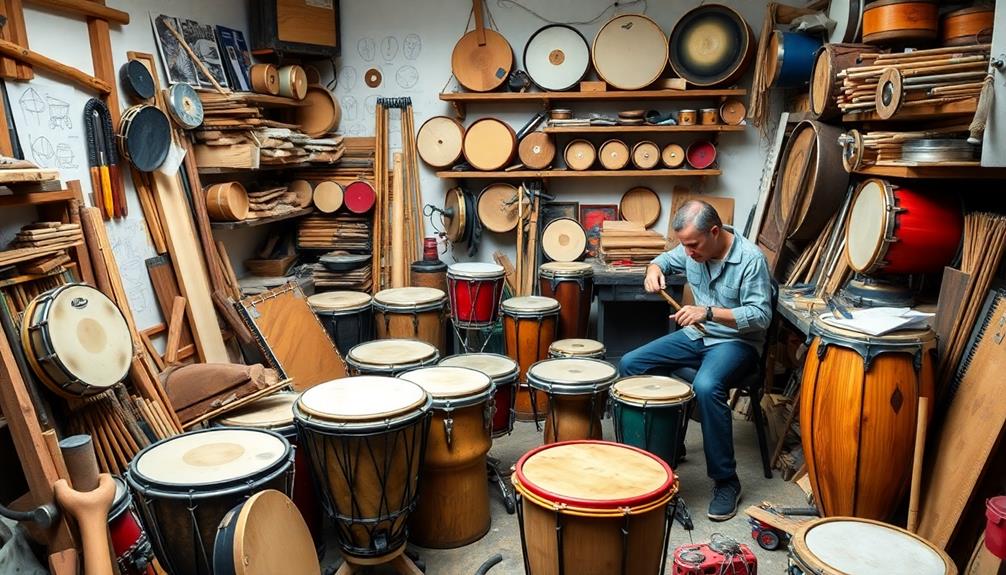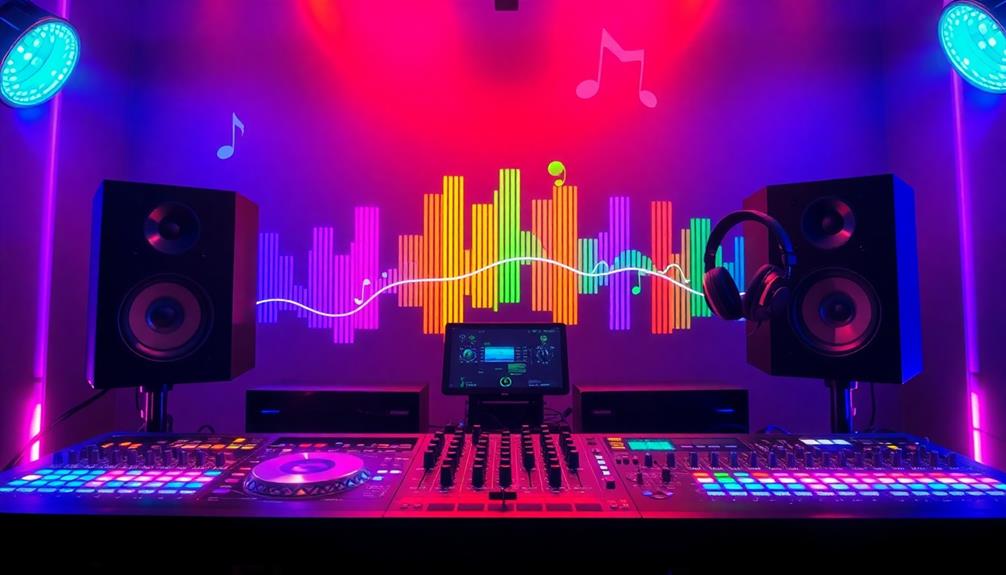You can build the perfect beat by creating your own drum kits from scratch using everyday objects. Start by experimenting with items like pillows, boxes, or even rice-filled containers to capture unique sounds. Layer multiple recordings to add depth and clarity, and apply techniques like normalization and EQ shaping to refine your samples. Don't forget to explore pitch manipulation and compression for enhanced dynamics. By continuously experimenting and recording, you'll craft an impressive library of sounds. If you're keen for tips on expanding your creativity and techniques, there's plenty more to discover! Remember to pay attention to rhythm and timing as you piece your sounds together, ensuring that each layer complements the others seamlessly. By fine-tuning each element and trusting your creative instincts, you can craft beats that hit hard and leave a lasting impression. Keep pushing boundaries and incorporating unconventional ideas to make your music truly stand out.
Key Takeaways
- Experiment with everyday objects like pillows and boxes to record unique kick and percussion sounds, enhancing your drum kit's originality.
- Layer multiple sounds together to create depth and complexity in your drum kits, ensuring a richer audio experience.
- Apply sound processing techniques such as normalization, EQ shaping, and compression to refine your samples for clarity and punchiness.
- Explore pitch manipulation and time-stretching to customize the tonal quality of your drum sounds for added creativity.
- Continuously build a library of unique sounds through recording and experimentation, keeping your drum kits fresh and exciting.
Exploring Sound Creation Techniques

When you immerse yourself in exploring sound creation techniques, you'll discover a world of possibilities using everyday objects. You can utilize items like pillows and towels to create unique kick sounds by experimenting with the impact and resonance they produce.
Don't shy away from making weird sounds; they can lead to surprising results.
Try layering multiple sounds together to enhance the depth and complexity of your drum kits. This approach results in richer and more textured kick drum elements that stand out.
As you record, manipulate pitch and apply time-stretching techniques to your sounds for unique sonic effects. These transformations can really change the character of your drum sounds.
Make sure to continuously record and build an extensive library of unique sounds. Refine these recordings through processing chains that include normalization, EQ shaping, and compression for ideal clarity and punchiness.
Don't forget to explore different environments, like empty boxes, to capture diverse kick drum textures. Each location can offer different methods to experiment with, providing you an even broader foundation for your custom drum kits.
Your creativity is the limit!
Mastering Sound Processing Methods
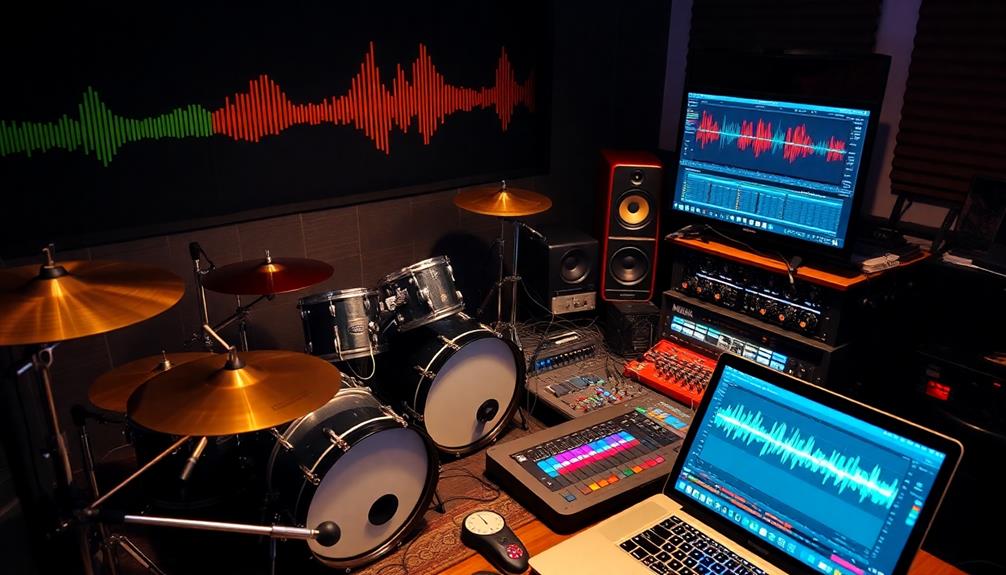
Mastering your sound processing methods is vital for achieving polished and professional drum kits. To guarantee your drum sounds stand out, focus on these key techniques:
- Normalization: Apply normalization techniques to enhance sound levels and clarity. This makes each drum hit prominent in your mix, preventing any elements from getting lost.
- EQ Shaping: Utilize EQ shaping to adjust frequency ranges. Low cuts remove unwanted muddy frequencies, while boosts enhance desirable tones, giving you better control over your drum kit's sound.
- Compression: Use compression, especially for kick sounds, to add punchiness. Adjust the attack and release settings to highlight the transient peaks and make your kicks more impactful.
- Clipping: Incorporate clipping to introduce a distorted effect. This adds character and texture to your sounds, giving them a unique edge that can set your drum kit apart.
Consistently monitoring levels during recording is essential. It prevents clipping and guarantees that your processed sounds maintain their integrity and quality, resulting in a professional-sounding drum kit.
Crafting Unique Kick Drum Sounds

After honing your sound processing skills, it's time to focus on crafting unique kick drum sounds that can elevate your tracks.
Start by experimenting with everyday objects like pillows and towels. Record the thuds and thumps they produce, then layer these sounds to add depth and complexity to your kick drum.
Next, utilize pitch manipulation techniques. Adjust the pitch and try time stretching to enhance the character of your samples.
Don't hesitate to explore different environments; recording kick sounds from empty boxes can yield distinct textures that transform into usable kick drums.
Once you have your samples, apply processing techniques such as normalization, EQ shaping, and compression. This refinement guarantees your kick sounds are punchy and clear.
Designing Shaker and Percussion Sounds
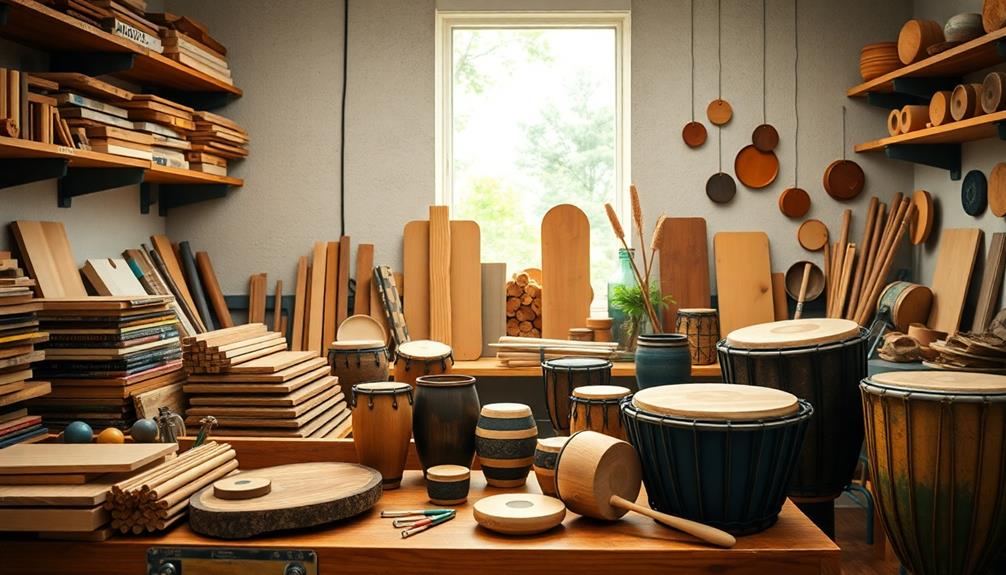
When designing shaker and percussion sounds, you should start by experimenting with various everyday objects to find unique tones.
Once you've captured your sounds, processing them for clarity is essential to guarantee they fit seamlessly into your mix.
Sound Selection Techniques
Creating unique shaker and percussion sounds can greatly enhance your drum kit's character. To achieve this, you'll want to explore various sound selection techniques that foster creativity and depth in your beats.
Here are four methods to examine:
- Experiment with Everyday Objects: Use items like pill bottles or boxes to capture interesting sounds. You'd be surprised at the unique textures you can produce with common objects.
- Layer Your Sounds: Record a variety of percussive sounds and mix them together. This layering technique can create rich, complex textures that make your shakers stand out.
- Engage with Online Resources: Tap into tutorials and community feedback. Engaging with fellow sound designers can introduce you to innovative methods and broaden your skill set.
- Utilize Creative Processing: Apply effects like fading, chorus, or delay to your recordings. This can add depth and make your shaker and percussion sounds more dynamic and engaging.
Processing for Clarity
Often, achieving clarity in your shaker and percussion sounds requires thoughtful processing techniques that highlight their unique qualities. Start by normalizing your recorded sounds to enhance their overall levels, ensuring they sit well in the mix. This simple step boosts the clarity and presence of your percussive elements, similar to how regular cleaning is essential for peak performance in air purifiers.
Next, apply fading techniques to eliminate abrupt starts and ends in your audio clips. Smoother shifts can markedly improve how your shaker and percussion sounds blend with other instruments.
Don't forget to utilize EQ; remove unwanted frequencies while boosting desired ranges to refine the definition of your sounds. Experimenting with effects can also elevate your percussion textures. Adding chorus and delay to your shaker sounds enriches their texture, creating a more dynamic audio experience.
Additionally, record a variety of sounds using containers and household items. Process these recordings with normalization and EQ to uncover unique percussive textures for your drum kits.
Creative Layering Methods
In the quest for unique shaker and percussion sounds, layering plays an essential role in enhancing your drum kits. By creatively combining different audio elements, you can craft sounds that stand out and add depth to your tracks.
Here are some effective methods for layering shaker and percussion sounds:
- Daily Objects: Experiment with everyday items like pill bottles or rice-filled containers. These can yield unique shaker sounds that introduce texture to your drum kits.
- Multiple Layers: Combine various shaker noises or subtle background textures. Layering different sounds creates a richer and more complex audio experience, making your rhythm section more interesting.
- Sound Processing: Use techniques like normalization and EQ shaping to enhance clarity in your recordings. This helps eliminate unwanted frequencies and guarantees that each layer cuts through the mix.
- Effects: Incorporate effects such as chorus and delay to add depth and dimension. These effects can transform ordinary sounds into something more enchanting, making your percussion stand out in any mix.
Continuously experiment with these methods, and you'll discover endless possibilities for crafting the perfect shaker and percussion sounds.
Utilizing Everyday Objects for Sounds

Every musician's environment is filled with potential sound sources just waiting to be explored. You can find unique kick sounds by striking everyday items like pillows and towels. These common objects demonstrate the versatility in sound design that you can tap into, much like how the best heat pumps utilize advanced technology for efficiency.
Don't stop there; experiment with various materials such as empty boxes or crumpled paper. You'll discover distinctive percussive effects that can greatly enhance your drum kit's diversity.
When you layer sounds created from these everyday items, you can build richer kick drum textures, adding depth to your beats. Focus on utilizing lower frequency sources, as they're vital for crafting authentic kick sounds that resonate well in your music production.
Recording multiple sound variations from everyday objects gives you a vast library to work with. This allows for continuous experimentation and refinement of your drum kits, ensuring you keep your sound fresh and exciting.
Layering and Pitch Manipulation

Layering sounds is a powerful technique that can elevate your drum kits to new heights. By combining multiple kick drum sounds, you can create a richer texture that enhances the overall impact of your beats.
Don't be afraid to play around with different frequencies and characteristics—this experimentation can lead to more dynamic and engaging drum kits.
Pitch manipulation is another valuable tool in your arsenal. By adjusting the tonal quality of your kick drums, you can craft unique sounds that fit the vibe of your track perfectly.
Here are some strategies to contemplate:
- Blend Low and High Frequencies: Layer high-frequency elements with low-frequency kicks to add depth and complexity.
- Utilize Time Stretching: Transform ordinary sounds into compelling percussive elements by stretching or compressing their duration.
- Record Continuously: Keep recording and processing layered sounds to build an extensive library of unique kicks.
- Experiment Boldly: Don't hesitate to tweak pitch and layering; the unexpected can often yield the most exciting results.
With these techniques, you'll gain greater creativity and customization in your drum kit creation.
Enhancing Sounds With Compression

Compression is an essential technique for enhancing the sounds of your drum kits, particularly when it comes to kick drums. It controls the dynamic range, making your kick sound more consistent and impactful in the mix.
By adjusting the attack and release settings, you can customize how the kick responds: faster attack times highlight the initial punch, while longer release times help sustain the sound.
To apply compression effectively, set a ratio between 2:1 and 4:1, which determines how much the signal reduces once it hits the threshold level. This shaping process is crucial for defining the character of your kick.
However, always monitor your levels during compression. Too much can lead to unwanted clipping, distortion, and a loss of clarity.
You might also want to experiment with sidechain compression. This technique allows the kick drum to pop out more prominently by dynamically reducing the volume of other elements whenever the kick hits, creating a rhythmic pumping effect that adds energy to your track.
Use these compression techniques to elevate your drum sounds and achieve a polished, professional mix.
Engaging With Learning Resources
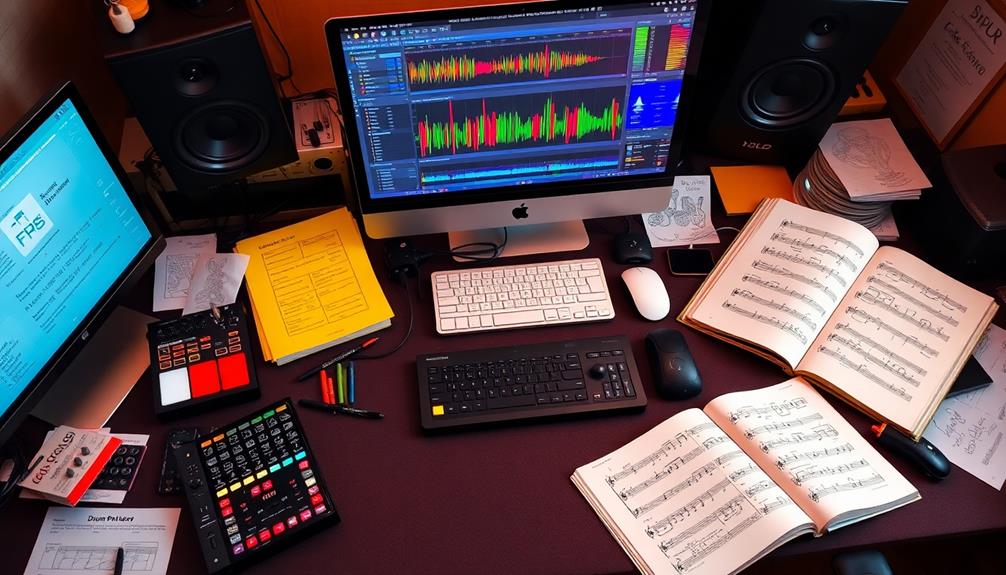
Exploring a variety of learning resources can greatly enhance your drum kit creation skills. By tapping into multiple avenues, you'll find valuable insights and techniques that can elevate your sound design. For instance, you might want to check out advanced mixing techniques that can improve your overall production quality.
Here are some essential resources to evaluate:
- Video Tutorials: Platforms like YouTube offer countless step-by-step guides on sound creation. You'll learn how to design unique drum sounds from scratch, making the process engaging and interactive.
- Online Communities: Engaging with forums and communities allows you to connect with fellow producers. Share your experiences, seek advice, and receive constructive feedback that can refine your skills.
- Experimentation: Many resources stress the importance of trying out different materials and environments. This experimentation can lead to discovering unique sounds that set your drum kits apart.
- Social Media Groups: Join music production groups on platforms like Facebook or Reddit. These groups keep you updated on the latest techniques, trends, and tools in drum sound design, ensuring you're always in the loop.
Building a Creative Community

Building a creative community around your drum kit projects can greatly enrich your experience and skills. Engaging with online platforms like YouTube opens up a world of video tutorials, allowing you to learn diverse sound creation techniques while sharing your own discoveries.
By participating in forums and social media groups focused on music production, you foster collaboration and receive valuable feedback, refining your drum kit designs and sparking new ideas.
Don't underestimate the power of local workshops and meetups. Joining these events enhances your learning and offers hands-on experiences, connecting you directly with fellow producers. It's a fantastic way to network and gain insights that you won't find online.
Sharing your original drum kits on platforms like SoundCloud or Bandcamp not only builds your personal brand but also invites constructive criticism from the community, fueling your growth.
Ultimately, actively contributing to discussions and sharing your experiences strengthens community ties. By promoting a culture of support and innovation, you'll inspire others and create a vibrant environment for all aspiring producers.
Embrace these opportunities, and watch your creativity flourish!
Frequently Asked Questions
How Do You Make a Drum From Scratch?
To make a drum from scratch, select a resonant material like a cardboard box. Experiment with striking it using sticks or hands, and record multiple hits to layer sounds for a unique drum effect.
How to Make Your Own Drum Pack?
To make your own drum pack, start recording unique sounds from everyday objects. Process them with EQ and compression, layer different elements, and keep refining your samples for a diverse, dynamic collection ready for music production.
How Do You Make Drum Kits Sound Good?
To make your drum kits sound good, think of layering sounds like painting with vibrant colors. Add compression for punch, experiment with pitch, and use EQ to sculpt frequencies, creating a dynamic and rich auditory experience.
What Makes a Good Drum Kit?
A good drum kit's got diverse sounds like kick, snare, and hi-hats. Quality samples matter, so guarantee they're well-recorded. Layering, customization, and sound processing techniques make your kit unique and polished for any genre.
Conclusion
In your journey to create the perfect drum kit, remember that 80% of professional producers use custom sounds to set their tracks apart. By exploring sound creation techniques and mastering processing methods, you can craft unique kicks, shakers, and percussion that resonate with your personal style. Don't hesitate to experiment with everyday objects and connect with a creative community. Embrace the process, and you'll discover a world of possibilities waiting to enhance your music production.

